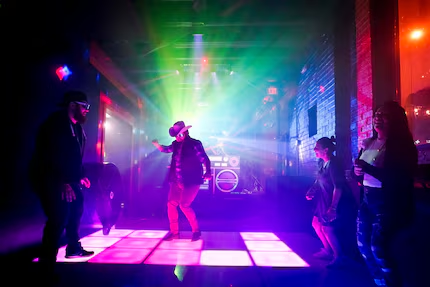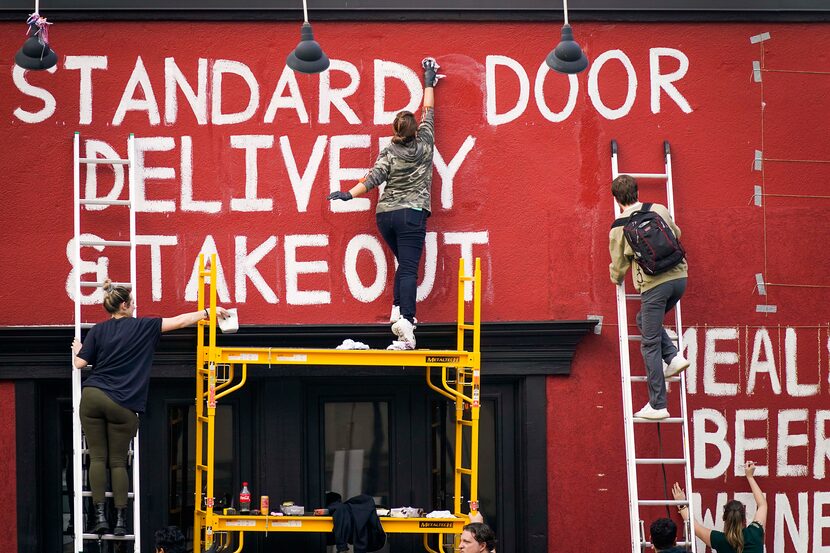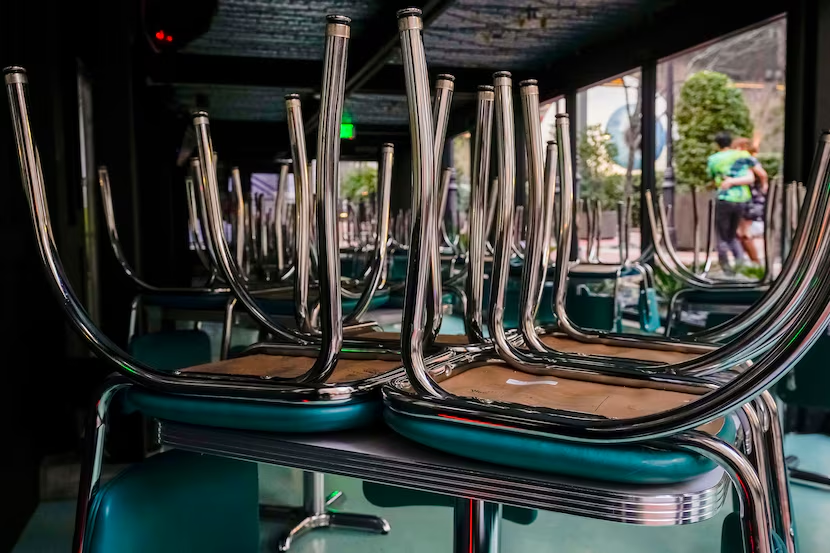The economic impact of the coronavirus on restaurants in Dallas-Fort Worth will be monumental.
Independent restaurateur Tim Love, who lives in Fort Worth and owns 14 restaurants that employ 540 people, says he and his fellow restaurateurs never could have planned for a global pandemic that would force consumers to stay home for weeks.
“It’s worse than a tornado, it’s worse than a hurricane, it’s worse than a fire,” he says. “This is going to destroy everything that I’ve built.” Timing is bad, too: He opened three new restaurants in Houston less than a week ago.
Love and every restaurateur in North Texas are tasked with figuring out how — or if — they will have viable businesses once the COVID-19 threat decreases and consumers visit restaurants en masse again. For now, President Donald Trump, the mayor of Dallas and other regional leaders are urging or forcing consumers out of restaurants.
The industry was built on slim margins, which means restaurants may fail faster than other businesses. Margins are very thin, 10% or less, said several local restaurateurs. The president and CEO of the Texas Restaurant Association, Emily Williams Knight, says the margins could be as slim as 1% to 2%.
Most are not prepared for a disaster scenario.
“People carry cash for problems,” Love says. The air conditioner breaks. An ice storm keeps people away for a day or two. “They don’t carry cash for Armageddon.”
How can locally owned restaurants survive?
Love runs some simple math:
“Most restaurants average between 8% and 10% margins. That’s what they make. So do the math on that real quick: You’ve got 10% of a month to make it. If there are 30 days in a month, what’s 10% of 30? Three. So three days is how much cash people have, without any revenue.”
“Some people have double that, so call it six days. So a week," Love says. “That’s the norm, especially for mom-and-pops.”

Bradley Anderson — co-owner of Boulevardier, Veritas Wine Room, Rapscallion and Hillside Tavern in Dallas — agrees with Love. So does Ian Tate, executive chef at Lake House Bar and Grill near White Rock Lake in Dallas: Their restaurants can’t survive a crisis if profits are down for even one week.
“Most restaurants don’t have a cushion in the bank,” Anderson says. “It’s night to night.”
And, with the uncertainty of the coronavirus, Anderson says he’s “not confident there will be a solution.”
Love believes that half of Dallas-Fort Worth’s restaurants might close. The Texas Restaurant Association is predicting that 25% to 30% of independent restaurants will close if conditions continue.
“It is catastrophic,” Knight writes in an email. “We have a significant number of independent restaurants in Texas who we must support to make it through this crisis.”
Love is even more direct: “Those who own two [restaurants] need to focus on one,” he says.
It’s the same kind of take-no-prisoners advice he used to give on the CNBC show Restaurant Startup, where Love and others invested their own money in new restaurants.
Can a shift to takeout food be successful at sit-down restaurants?

Many restaurants, including Anderson’s, have already started selling food and drinks curbside.
Restaurateurs all over North Texas have been vocal about their plans to feed customers in new ways. With 13,500 restaurants and drinking establishments in Dallas, Fort Worth and Arlington, many have already launched social media campaigns to convince D-FW diners to spend their dollars locally.
Small business owner Wim Bens is turning Lakewood Brewing Co. into a drive-through beer stand with the eventual addition of food trucks. “The big guys will be all right through all of this, but the small, independent, family-owned businesses like us need help to stay afloat," he writes in an email to fans. In an effort to have some fun, Bens announced that customers will get a free roll of toilet paper while supplies last.
Another unique idea is the new sign at the Standard Pour in Uptown Dallas. Owner Eddie “Lucky” Campbell paid his staff to paint “DELIVERY & TAKEOUT” on the side of the building.
It’s too early to know how those efforts are paying off. But most agree that it won’t be enough.
Anderson explains to-go revenue this way: It’s “better than zero.”
Many sit-down restaurants were not set up to be successful to-go businesses, Love says. Lonesome Dove Western Bistro, his upscale restaurant in the Fort Worth Stockyards, is a good example: It’s a destination, not a drop-in.
Love’s restaurants have signed on with Uber Eats, and he’s still deciding how the restaurants should operate in the coming days or weeks. But he knows the difference in revenue will be significant.
“I’d love everybody to go out and support every restaurant there is and get to-go ... but people go to restaurants for community,” he says. “When you cut off community, the rest of it doesn’t seem to make sense."
Some determined restaurateurs are to trying to replicate that sense of community. Craig Spivey, who owns a bowling alley bar called Bowlski’s, started a website called Save Neighborhood Restaurants so restaurateurs in Lakewood could have a united front.
The Texas Restaurant Association says in a statement that forcing restaurants to a go-to model “will prove to be devastating to this industry and to working people.” The association guesses that 500,000 jobs could be lost.
How long might restaurants suffer?
Mayors in Dallas and Fort Worth haven’t set end dates on the restrictions placed on restaurants and bars. Business owners are at the mercy of the government, restaurateurs say.
No one interviewed thinks it’ll end quickly.
Love guesses restaurant sales will suffer for six to eight weeks — which is a big leap from the three to six days that some restaurants can go without revenue.

“Don’t get me wrong: I’m not doom and gloom here,” Love says. “I’m the most optimistic person on the planet. People just have to stand back and realize this is real. It’s not going away.”
Anderson guesses they’re in for at least a month of challenges and uncertainty.
Love says he won’t be paying himself for at least eight weeks.
He has pledged to provide free school lunches at his restaurants, which he says will help kids in need while keeping some of his workers busy and focused on a positive task.
Hourly restaurant workers face the most uncertainty since they don’t have salaries to cover them for part or all of the slowdown. The owners of Oddfellows and Revelers Hall, two restaurants in Oak Cliff, laid off 50 people on March 16.
Love urges other restaurateurs to stop “begging people to come in” right now because he believes that will extend the time that restaurants will suffer. His suggestion is to “hunker down, white-knuckle it, and at the end of six weeks, hopefully this thing is all died off.”
“And that’s when we beg for people to bring the dollars.”
‘How do we make sure we open back up?’
It will be tough for restaurateurs to look ahead a month or two. But restaurateurs like Love who are being frank say the challenge is bigger than surviving three or six days; it’s about not being part of the 50% of restaurants he thinks will close.
“The goal, as I’ve said a million times, is "How do we make sure we open back up?'” Love says. “You need to call your landlord and get a concession for two months. You need to call the alarm company and say, ‘Hey, we can’t pay for two months.’”

Some restaurateurs may have leverage with their landlords. In these dramatic economic times, “There’s nobody behind you to pay the rent," Love points out. "Who’s going to fill the space?” He suggests asking landlords to tack a month or two of rent onto the end of the lease.
Financial assistance might be available for restaurants, airlines and other industries if the Trump administration can pass a $1 trillion stimulus package. At that price tag, it would be “one of the largest federal emergency fiscal packages ever assembled,” says the The Washington Post.
The Texas Restaurant Association created a campaign on March 17 that demands action from Texas officials. It allows people to send messages to their elected officials. On behalf of the association, Knight is urging state and federal officials to support grants for small businesses, to offer tax credits and to prohibit landlords from evicting restaurants for nonpayment of rent.
Tate says the restaurant he works at in East Dallas doesn’t want to rely on government dollars. He was a chef in New Orleans during Hurricane Katrina and remembers the heartache.
Love believes the government should step in, and he says that would help his small business significantly.
“The president says don’t go to restaurants — which I think is the right move — but where’s the bailout for restaurant people?” Love says. “We take care of people — and we love to take care of people. This is the first time, ever, in U.S. history, where something’s got to happen for our industry.”


